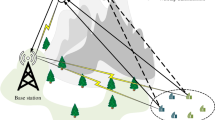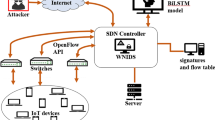Abstract
Fifth generation (5G) cellular networks provide high speed services to the users in multimedia applications. Generally, a 5G network consists of large (Macro) and small (Femto/Micro) cells to provide variety of services to the User Equipments (UEs), having different requirements. Heterogeneous Networks (HetNets) contain small cells in the coverage region of macro cells. Resource allocation (RA) is a process of allocating available resources to the users according to their Quality of Service (QoS) demands. But resource allocation in 5G HetNets become challenging due to Interference among cells and Handoff. As Internet of Things (IoT) edge devices have dynamic traffic requirements, it will be difficult to allocate resources for them. In this paper, we propose an Intelligent RA Decision (IRAD) which is formulated and analyzed. In IRAD, Deep Learning based Encoder with Neural Network (DL-ENN) architecture is designed to classify the end IoT devices depending on their QoS requirements and traffic characteristics. From the output of classified results, optimum RA decisions are made to each device. In RA strategy of femtocells, the transmit power and allocated resources of each femtocell user are optimized such that minimum data rate requirements of femtocell users are satisfied and interference power from femtocells to the macro cells is reduced. The Improved Chicken Swarm Optimization (ICSO) algorithm is used for optimized RA decision to small cell users. By simulation results, we show that the proposed IRAD technique provides maximum resource utilization and throughput with reduced packet loss ratio.














Similar content being viewed by others
Abbreviations
- 5G:
-
Fifth Generation
- ANN:
-
Artificial Neural Network
- BRD:
-
Behavior of Resource Demand
- CCI:
-
Co Channel Interference
- CHO:
-
Chicken Swarm Optimization algorithm
- CNN:
-
Convolution Neural network
- CSI:
-
Channel State Indicator
- CSO:
-
Chicken Swarm Optimization
- D2D:
-
Device to Device
- DL:
-
Deep Learning
- DL_ENN:
-
Deep Learning_ Encoder Neural Network
- DNN:
-
Deep Neural Network
- EDRL:
-
Enhanced Deep Reinforcement Learning
- FeNB:
-
Femtocell Base Station
- HetNets:
-
Heterogeneous Networks
- IoT:
-
Internet of Things
- IRAD:
-
Intelligent Resource Allocation Decision
- LTEA:
-
Long Term Evolution-Advanced
- M2M:
-
Machine-to-Machine
- MIMO:
-
Multiple Input Multiple Output
- ML:
-
Machine Learning
- NOMA:
-
Non-Orthogonal Multiple Access (NOMA).
- PSO:
-
Particle Swarm Optimization
- QoE:
-
Quality of Experience
- QoS:
-
Quality of Service
- QoS-ARS:
-
QoS-aware Resource Allocation and femtocell Selection
- RA:
-
Resource Allocation
- UE:
-
User Equipments
- WiFi:
-
Wireless Fidelity
References
Xu, Y., Gui, G., Gacanin, H., & Adachi, F. (2021). Survey on resource allocation for 5G heterogeneous networks: current research, future trends, and challenges. IEEE Communications Surveys & Tutorials, 23(2), 668–695.
Ismail, S., D’andreagiovanni, F., Lakhlef, H., & Imine, Y. (2020). Recent advances on 5G resource allocation problem using PD-NOMA. In IEEE International Symposium on Networks, Computers and Communications.
Hasan, M., & Hossain, E. (2016). Distributed resource allocation in 5G cellular networks. arXiv:1409.2475v1.
Zahoor, S., & Mir, R. N. (2021). Resource management in pervasive internet of things: A survey. Journal of King Saud University-Computer and Information Sciences, 33, 921–935.
Goswami, P., Mukherjee, A., Chatterjee, P., & Yang, L. (2021). An optimal resource allocation method for IoT network. In IEEE Proceedings of the 2021 International Conference on Distributed Computing and Networking (ICDCN ’21 Adjunct).
O’Shea, T., & Hoydis, J. (2017). An introduction to deep learning for the physical layer. IEEE. https://doi.org/10.1109/TCCN.2017.2758370
Aceto, G., Ciuonzo, D., Montieri, A., & Pescapé, A. (2019). Mobile encrypted traffic classification using deep learning: Experimental evaluation, lessons learned and challenges. IEEE Transactions on Network and Service Management, 12(3), 445–458.
Abozariba, R., Naeem, M. K., Patwary, M., Seyedebrahimi, M., Bull, P., & Aneiba, A. (2019). NOMA based resource allocation and mobility enhancement framework for IoT in next generation cellular networks. IEEE Access, 6(8), 29158–29172.
Pereira, R. S., Lieira, D. D., Silva, M. A. D., Pimenta, A. H., da Costa, J. B., Rosário, D., & Meneguette, R. I. (2020). RELIABLE: Resource allocation mechanism for 5G network using mobile edge computing. Sensors, 20, 5449.
Al-Zahrani, M. F. A., Khan, I., Zareei, M., Zeb, A., & Waheed, A. (2021). Resource allocation and optimization in device-to-device communication 5G networks. Computers, Materials & Continua. https://doi.org/10.32604/cmc.2021.018386
Zhang, T., Gao, Y., Li, Z., Li, P., & Dong, M. (2018). Resource Allocation for IoT Devices in FeD2D Communication Networks. In IEEE 4th International Conference on Computer and Communications.
Yaru, Fu., Yang, X., Yang, P., Wong, A. K. Y., Shi, Z., Wang, H., & Quek, T. Q. S. (2021). Energy-efficient offloading and resource allocation for mobile edge computing enabled mission-critical internet-of-things systems. Springer.
Nguyen, L. D. (2018). Resource allocation for energy efficiency in 5G wireless networks. In EAI Endorsed Transactions on Industrial Networks and Intelligent Systems., 5(14), e1.
Xie, H., & Yongjun, Xu. (2021). Robust resource allocation for NOMA-assisted heterogeneous networks. Elsevier.
Liu, J.-S., Lin, C.-H., & Huang, H.-C. (2019). Joint congestion control and resource allocation for energy-efficient transmission in 5G heterogeneous networks. Springer.
Angelakis, V., Avgouleas, I., Pappas, N., Fitzgerald, E., & Yuan, D. (2016). Allocation of heterogeneous resources of an IoT device to flexible services. IEEE Internet of Things Journal, 3, 691–700.
AlQerm, I., Wang, J., Pan, J., & Liu, Y. (2021). BEHAVE: Behavior-aware, intelligent and fair resource management for heterogeneous edge-IoT systems. IEEE Transactions on Mobile Computing, 21(11), 3852–3865.
AlQerm, I., & Pan, J. (2021). DeepEdge: A new QoE-based resource allocation framework using deep reinforcement learning for future heterogeneous edge-IoT applications. IEEE Transactions on Network and Service Management, 18(4), 3942–3954.
Mohajer, A., Daliri, M. S., Mirzaei, A., Ziaeddini, A., Nabipour, M., & Bavaghar, M. (2022). Heterogeneous computational resource allocation for NOMA: toward green mobile edge-computing systems. IEEE Transactions on Services Computing. https://doi.org/10.1109/TSC.2022.3186099
Nikjoo, F., Mirzaei, A., & Mohajer, A. (2018). A novel approach to efficient resource allocation in NOMA heterogeneous networks: multi-criteria green resource management. Applied Artificial Intelligence, 32(7), 1–8.
Mohajer, A., Sorouri, F., Mirzaei, A., Ziaeddini, A., Rad, K. J., & Bavaghar, M. (2022). Energy-aware hierarchical resource management and backhaul traffic optimization in heterogeneous cellular networks. IEEE Systems Journal, 16(4), 5188–5199.
Wang, J., Cheng, Z., Ersoy, O. K., Zhang, M., Sun, K., & Bi, Y. (2019). Improvement and application of chicken swarm optimization for constrained optimization. IEEE Access. https://doi.org/10.1109/ACCESS.2019.2913180
Bouaziz, A., Saddoud, A., Chaari, L.,& Chaouchi, H. (2016). QoS-aware resource allocation and femtocell selection for 5G heterogeneous networks. https://doi.org/10.21203/rs.3.rs-471274/v1.
Author information
Authors and Affiliations
Corresponding author
Additional information
Publisher's Note
Springer Nature remains neutral with regard to jurisdictional claims in published maps and institutional affiliations.
Rights and permissions
Springer Nature or its licensor (e.g. a society or other partner) holds exclusive rights to this article under a publishing agreement with the author(s) or other rightsholder(s); author self-archiving of the accepted manuscript version of this article is solely governed by the terms of such publishing agreement and applicable law.
About this article
Cite this article
D, R., P, P. & D, G. Intelligent resource allocation decision using deep learning and optimization techniques for HetNets. Wireless Netw 29, 3105–3119 (2023). https://doi.org/10.1007/s11276-023-03360-2
Accepted:
Published:
Issue Date:
DOI: https://doi.org/10.1007/s11276-023-03360-2




